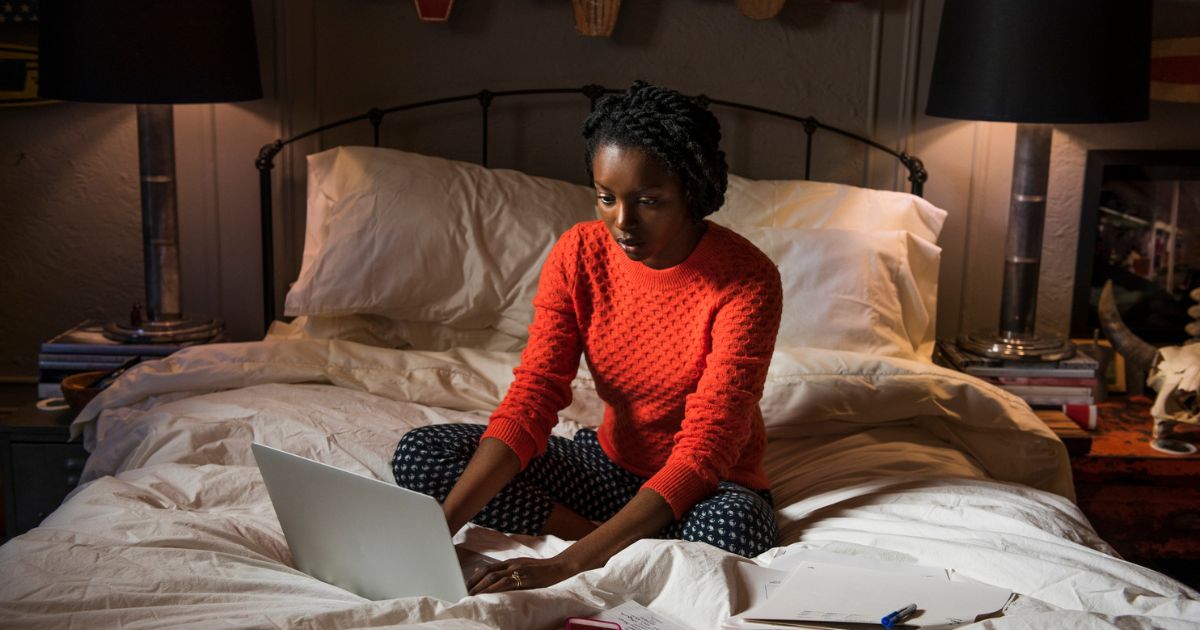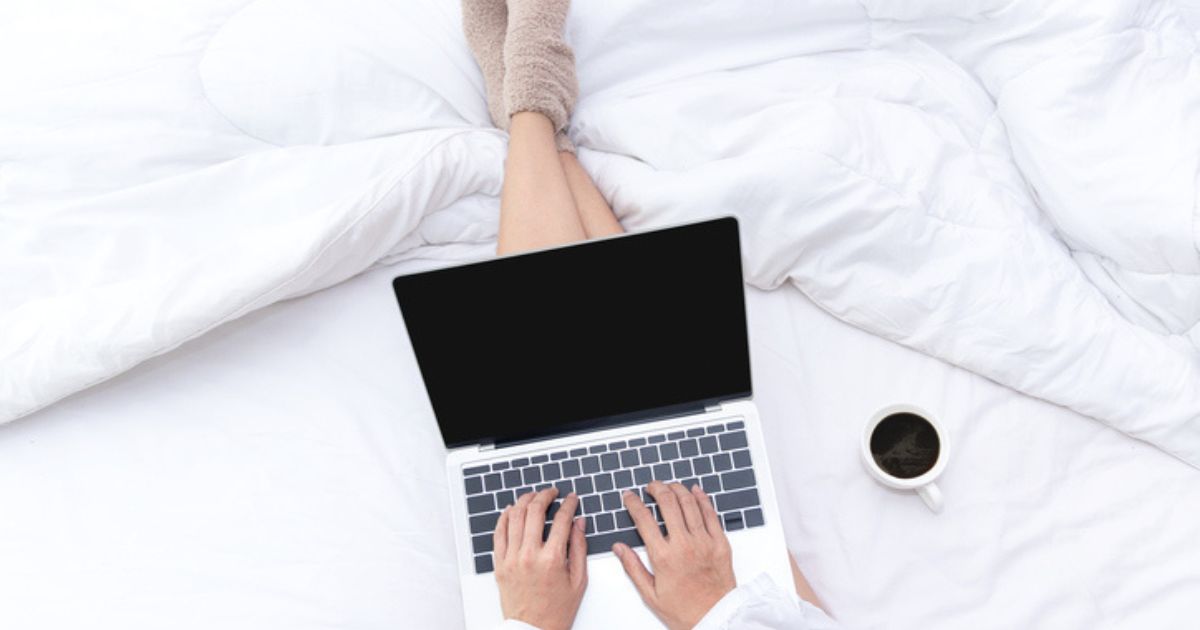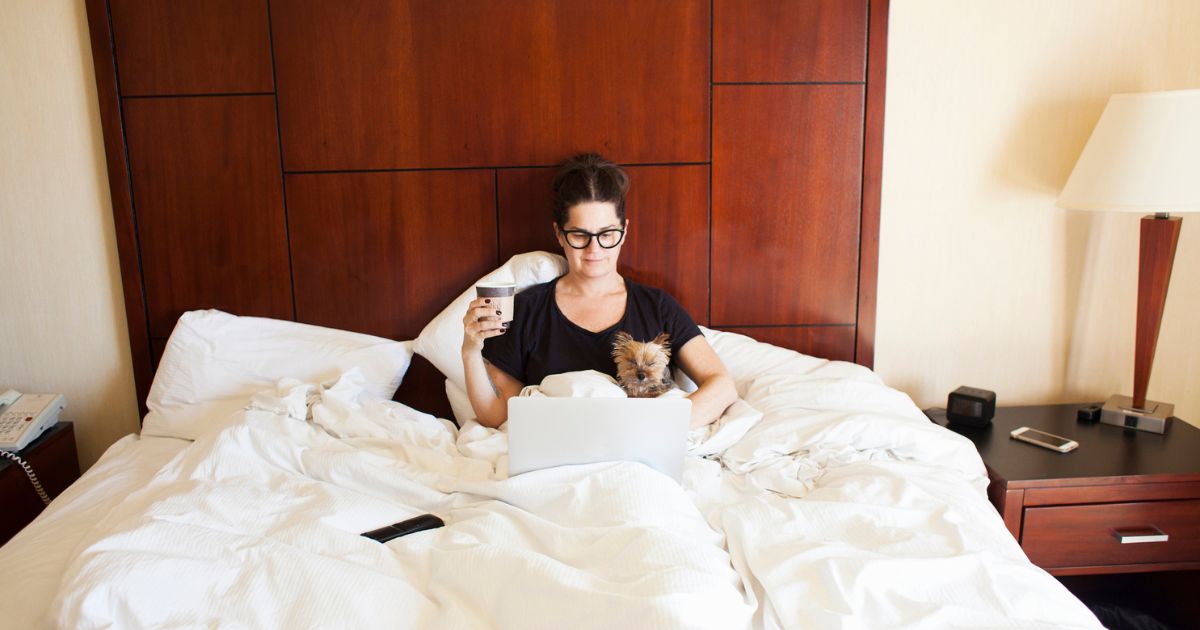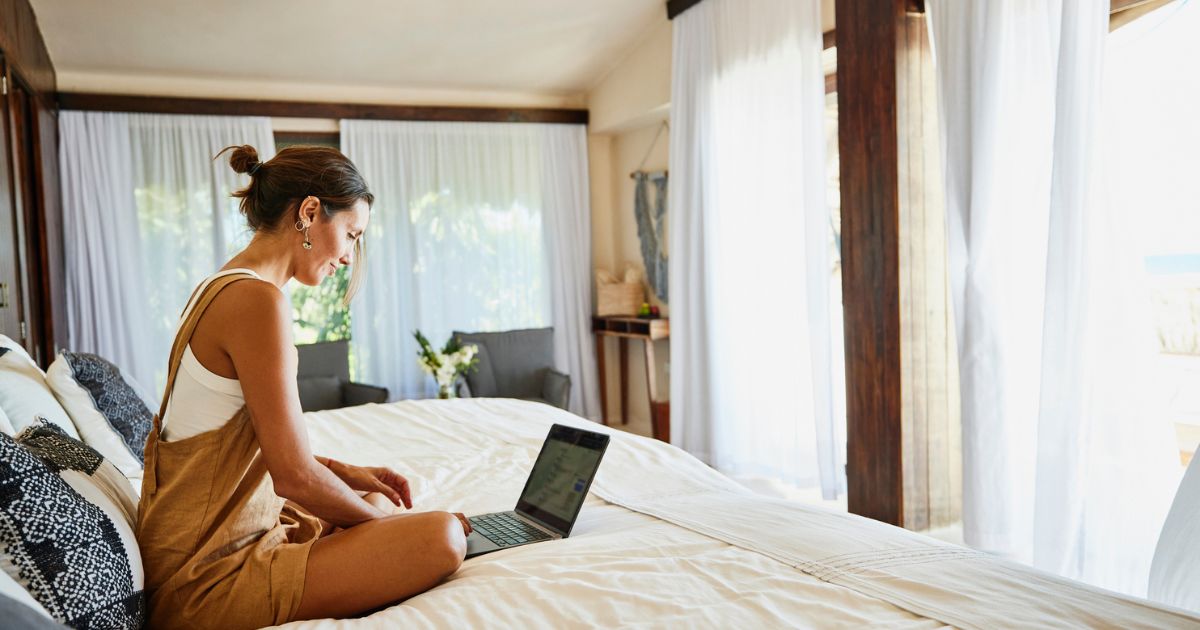Good Posture on Bed While Using a Laptop

No one will judge you when you use your laptop on the bed.
The temptation of taking your laptop to bed for just a little bit more work or catching up on the latest episodes of your favorite show is always there.
Even while working on the road as many temporary lodgings don’t even come with enough space to accommodate your work.
The best part of having a laptop is having a machine that you can easily travel with and use anywhere, even if that means in a hotel or hostel bed.
The problem comes when we give in to this temptation without knowing how to use a laptop in a bed comfortably.
This then precedes strain on the upper and lower back, tension headaches, and stiff necks.
Using your laptop on the bed in the right way will keep you comfortable, free from aches, and your laptop safe from damage.
If it’s not that, then the fact that sleeping with the laptop in the wrong position can potentially cause your system to overheat and get damaged is enough to motivate us to know how to use a laptop in a bed.
Overheating will kickstart the destruction of so many key components of the laptop.
Due to the portable nature of laptops, it is assumed that they can be used almost anywhere.
Although this is true, it still does not change the fact that certain locations will not allow for optimum use.
Using a laptop in bed is not bad if the right measures have been taken to ensure convenience and comfort.
Here are some useful tips on how to maintain proper posture while using your laptop in bed.
1] Mind Your Posture

It’s easy to slouch when sitting in front of a computer, laptop, or otherwise. Slouching becomes even more attractive when you’re curled up in bed.
For the right ergonomics, though, you must be sure to sit up straight and square to the laptop. lie with your head and knees raised.
When using your laptop in bed, the best position requires propping the computer above the knees at an angle of 45 degrees.
To attain this, you need to place a pillow under your neck to ensure your head stays up. The head and knees should be at the same level.
Your elbows should be bent at no more than 90 degrees, and your wrists should be straight, ideally placed on wrist rests.
It can be helpful to place a three-ring binder under the laptop on your lap so that it slopes down toward you and makes it more comfortable to keep your elbows and wrists in the correct position.
Keep your head and neck positioned so that your shoulders are back and your ears are directly above your shoulders.
With this position, you can look at the laptop at a good angle similar to using it on a desk.
Check yourself every few minutes (set a timer if you have to) to be sure you’re sitting up straight.
2] Proper Back Support Ideas

Proper back support is vital no matter where you’re using your laptop, but in bed, it’s harder to achieve.
You need to lie in bed with a pillow or something to support your neck and head and then raise your knees to about the same height as your head.
To support your spine adequately, sit with your back against the wall or headboard of your bed.
Place a small pillow or several pillows behind your lower back for additional lumbar support, and place another pillow under your knees.
You shouldn’t feel any inclination to hunch over, slide downward or turn sideways; keeping the laptop screen directly in front of you is important if you want to avoid cricks in your neck and back.
Regardless of where you are using your laptop, proper back support is essential for the health of your spine.
However, to use your laptop in bed, the pillow is a must-have accessory.
Seeing as most beds lack backrests that are present in chairs, the best alternative is to purchase pillows.
When these pillows are strategically placed on the bed, you can support your back.
To position the pillow for back support, follow these steps:
- Step 1: Ensure you are close to the headrest of the bed or a wall close to your bed.
- Step 2: Place a pillow or several pillows depending on your body mass behind the lower back. Doing this gives additional lumbar support to your back to prevent discomfort.
- Step 3: Get another pillow and place it under the knees. This action prevents you from hunching over or bending sideways.
3] How Frequent Should You Stretch?
No matter which type of set-up you have for working on your bed with your laptop, there is still no escaping the truth that the design of the laptop was not originally meant for use on a bed.
This means that you can only drastically limit the negative effects, but you might not be able to completely nullify them.
Therefore, it would be best to get up at certain intervals to loosen up the body.
Laying in bed for long intervals can have an adverse impact on parts of the body get up after a certain period to stretch and allow blood to flow to all parts of the body.
Try to always try out a few stretches at intervals you feel your body getting taxed.
The stretches will liberate blood flow that might have stopped with the position your body might have taken to accommodate the laptop on your bed.
4] Laptop On A Pillow Or Blanket – Do or Don’t
You run the risk of letting your laptop crash or overheat by placing it on a pillow or blanket.
This is due to the fact that these accessories for the bedroom are insulators of heat.
The laptop emits heat from the bottom and sides and if there is no way for cool air to enter, it leads to overheating.
All your laptop might need is decent airflow.
So at long as the air intakes (probably on the bottom of the laptop) and air outtake (probably on the side or back) aren’t blocked you’re good to go.
So long as your laptop can breathe the only constraint on how you place your laptop is your own comfort (and viewing angle of the screen).
5] Can You Sit Cross-Legged With The Laptop At Your Front?
If you adopt this position to use your laptop on the bed, it affects our back most of all, sometimes immediately, and this ache accumulates as we continue to hunch our backs to work on our beds.
Your back will end up hunched in order to adopt a close position to the laptop screen.
Apart from that, it places stress on your neck as you look down at your laptop, which will place a similar strain on the bones and muscles of the neck.
Also, While you use your system in this position, you may not feel it, but the impact will definitely be felt the next day.
Sitting cross-legged is definitely not the best way to sit in bed with a laptop, it exemplifies bad posture in this case, and you would do well to stay away from doing it.
The best laptop position bed is lying down, as you are about to read in point two.
6] Use Additional Equipment
As mobile laptops are, the internal keyboards and mice don’t usually provide as much convenience as they should when you’re in an unorthodox workplace like the top of your bed.
A better option is to have an external keyboard and an external mouse, which is preferably wireless.
With external devices, especially if they are wireless, you have an unlimited choice of degrees of freedom to play with.
This way, you don’t have to put your shoulders, arms, and fingers through the stress and strain they would normally go through in those unnatural positions.
If you maintain a right-angle position while you’re using these devices to keep them close to the body, you will say goodbye to neck strains too.
To ensure ideal laptop usage in bed, you may try some of the many tools that are designed to help.
Sometimes, all you need to do to get the most comfortable way to use a laptop in bed is buy a few gadgets.
There is a host of ergonomic equipment geared at making sure you have a nice and comfortable time using your laptop at any place, and in any position.
An external mouse and keyboard should be your choice instead of a touchpad when possible, in order to help you maintain the correct arm and wrist position.
In addition, a portable laptop desk or stand can be a valuable resource for computing when you’re away from a standard desk.
It will sit your laptop over your legs. So, you’re pretty much in your normal sleeping position except you have your laptop working over your legs.
These devices raise the laptop and place it at an angle, an action that serves two purposes: you can avoid bending your neck to see the screen if it’s raised to eye level, and the angled position helps you to maintain the correct placement of your arms and hands.
You can care for your laptop even more by buying laptop cooling cushions to deal with the overheating problem directly when you’re using the laptop.
Since the angle might not be completely favorable, you can also buy a neck pillow to even out the bending angle for your neck to allow you to see the screen more comfortably.
If you’re stuck in a dark room, then external keyboard lights are also available to help you get work done in comfort.
Depending on the size of the laptop as well. A smaller one, of course, can easily lie on your lap.
A larger one can be a bit uncomfortable; for that, you might consider getting a laptop tray, although a footstool can service just as well.
Keep in mind that the underside of laptops can get quite hot. As such, you should probably put a sheet under it.

![Good Posture for Bassists [Best Posture for Playing Bass]](https://www.goodposturehq.com/wp-content/uploads/thumbs_dir/Good-Posture-for-Bassists-prlo9r28a7kjuccnls4l0ln7wus4y8khcjvamosmhg.jpeg)
![Good Posture When You Draw [How to Get the Best Position]](https://www.goodposturehq.com/wp-content/uploads/thumbs_dir/Good-Posture-When-You-Draw-prlnpziekmihpj280qk0337a867a3d3oaq0qc83nbo.jpeg)
![Driving Posture Support [How to Achieve a Good Driving Position]](https://www.goodposturehq.com/wp-content/uploads/thumbs_dir/Driving-Posture-Support-prlmshjh06nlxtpymr9nq1iw2tbcrp420x0rm7rr2s.jpeg)
![Safest Driving Position [And Comfy for Long Trips]](https://www.goodposturehq.com/wp-content/uploads/thumbs_dir/Safest-Driving-Position-prlllxejk8e89fjh5czrts5jsr32925ku9nbd6vgt0.jpeg)
![SUV vs Sedan Good Driving Posture [Best Sitting Position]](https://www.goodposturehq.com/wp-content/uploads/thumbs_dir/Sedan-Good-Driving-Posture-prgr0xfu7wpe98up4mvnrs2g311miv57eesvnlpdck.jpeg)